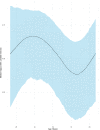Observational study of agreement between attending and trainee physicians on the surprise question: "Would you be surprised if this patient died in the next 12 months?"
- PMID: 33630939
- PMCID: PMC7906409
- DOI: 10.1371/journal.pone.0247571
Observational study of agreement between attending and trainee physicians on the surprise question: "Would you be surprised if this patient died in the next 12 months?"
Abstract
Background: Optimal end-of-life care requires identifying patients that are near the end of life. The extent to which attending physicians and trainee physicians agree on the prognoses of their patients is unknown. We investigated agreement between attending and trainee physician on the surprise question: "Would you be surprised if this patient died in the next 12 months?", a question intended to assess mortality risk and unmet palliative care needs.
Methods: This was a multicentre prospective cohort study of general internal medicine patients at 7 tertiary academic hospitals in Ontario, Canada. General internal medicine attending and senior trainee physician dyads were asked the surprise question for each of the patients for whom they were responsible. Surprise question response agreement was quantified by Cohen's kappa using Bayesian multilevel modeling to account for clustering by physician dyad. Mortality was recorded at 12 months.
Results: Surprise question responses encompassed 546 patients from 30 attending-trainee physician dyads on academic general internal medicine teams at 7 tertiary academic hospitals in Ontario, Canada. Patients had median age 75 years (IQR 60-85), 260 (48%) were female, and 138 (25%) were dependent for some or all activities of daily living. Trainee and attending physician responses agreed in 406 (75%) patients with adjusted Cohen's kappa of 0.54 (95% credible interval 0.41 to 0.66). Vital status was confirmed for 417 (76%) patients of whom 160 (38% of 417) had died. Using a response of "No" to predict 12-month mortality had positive likelihood ratios of 1.84 (95% CrI 1.55 to 2.22, trainee physicians) and 1.51 (95% CrI 1.30 to 1.72, attending physicians), and negative likelihood ratios of 0.31 (95% CrI 0.17 to 0.48, trainee physicians) and 0.25 (95% CrI 0.10 to 0.46, attending physicians).
Conclusion: Trainee and attending physician responses to the surprise question agreed in 54% of cases after correcting for chance agreement. Physicians had similar discriminative accuracy; both groups had better accuracy predicting which patients would survive as opposed to which patients would die. Different opinions of a patient's prognosis may contribute to confusion for patients and missed opportunities for engagement with palliative care services.
Conflict of interest statement
The authors have declared that no competing interests exist.
Figures


Similar articles
-
The Surprise Question and clinician-predicted prognosis: systematic review and meta-analysis.BMJ Support Palliat Care. 2024 Dec 25;15(1):12-35. doi: 10.1136/spcare-2024-004879. BMJ Support Palliat Care. 2024. PMID: 38925876 Free PMC article.
-
Association of Emergency Clinicians' Assessment of Mortality Risk With Actual 1-Month Mortality Among Older Adults Admitted to the Hospital.JAMA Netw Open. 2019 Sep 4;2(9):e1911139. doi: 10.1001/jamanetworkopen.2019.11139. JAMA Netw Open. 2019. PMID: 31517962 Free PMC article.
-
The "Surprise Question" Asked of Emergency Physicians May Predict 12-Month Mortality among Older Emergency Department Patients.J Palliat Med. 2018 Feb;21(2):236-240. doi: 10.1089/jpm.2017.0192. Epub 2017 Aug 28. J Palliat Med. 2018. PMID: 28846475 Free PMC article.
-
The Surprise Question as a Trigger for Primary Palliative Care Interventions for Children with Advanced Heart Disease.Pediatr Cardiol. 2022 Dec;43(8):1822-1831. doi: 10.1007/s00246-022-02919-8. Epub 2022 May 3. Pediatr Cardiol. 2022. PMID: 35503117
-
Predicting one-year mortality in heart failure using the 'Surprise Question': a prospective pilot study.Eur J Heart Fail. 2019 Feb;21(2):227-234. doi: 10.1002/ejhf.1353. Epub 2018 Dec 11. Eur J Heart Fail. 2019. PMID: 30548129
Cited by
-
End of life care in paediatric settings: UK national survey.BMJ Support Palliat Care. 2025 Feb 26;15(2):221-230. doi: 10.1136/spcare-2023-004673. BMJ Support Palliat Care. 2025. PMID: 39609076 Free PMC article.
-
Analysis of the surprise question as a tool for predicting death in neonates.Eur J Pediatr. 2025 Feb 7;184(2):182. doi: 10.1007/s00431-024-05879-8. Eur J Pediatr. 2025. PMID: 39918789 Free PMC article.
-
The Surprise Question and clinician-predicted prognosis: systematic review and meta-analysis.BMJ Support Palliat Care. 2024 Dec 25;15(1):12-35. doi: 10.1136/spcare-2024-004879. BMJ Support Palliat Care. 2024. PMID: 38925876 Free PMC article.
-
The last year of life for patients dying from cancer vs. non-cancer causes: a retrospective cross-sectional survey of bereaved relatives.Support Care Cancer. 2022 Jun;30(6):4971-4979. doi: 10.1007/s00520-022-06908-8. Epub 2022 Feb 21. Support Care Cancer. 2022. PMID: 35190893 Free PMC article.
-
The simple observational critical care studies: estimations by students, nurses, and physicians of in-hospital and 6-month mortality.Crit Care. 2021 Nov 15;25(1):393. doi: 10.1186/s13054-021-03809-w. Crit Care. 2021. PMID: 34782000 Free PMC article.
References
-
- Yourman LC, Lee SJ, Schonberg MA, Widera EW, Smith AK. Prognostic indices for older adults: a systematic review. JAMA [Internet]. 2012. January 11 [cited 2019 Jun 19];307(2):182–92. Available from: http://www.ncbi.nlm.nih.gov/pubmed/22235089. 10.1001/jama.2011.1966 - DOI - PMC - PubMed
-
- Downar J, Goldman R, Pinto R, Englesakis M, Adhikari NKJ. The “surprise question” for predicting death in seriously ill patients: a systematic review and meta-analysis. CMAJ [Internet]. 2017. April 3 [cited 2019 Jun 19];189(13):E484–93. Available from: http://www.ncbi.nlm.nih.gov/pubmed/28385893. 10.1503/cmaj.160775 - DOI - PMC - PubMed
-
- Vincent J-L, Moreno R. Clinical review: Scoring systems in the critically ill. Crit Care [Internet]. 2010. [cited 2019 Jun 19];14(2):207. Available from: http://www.ncbi.nlm.nih.gov/pubmed/20392287. 10.1186/cc8204 - DOI - PMC - PubMed
-
- Vincent J-L, Opal SM, Marshall JC. Ten reasons why we should NOT use severity scores as entry criteria for clinical trials or in our treatment decisions*. Crit Care Med [Internet]. 2010. January [cited 2019 Jun 19];38(1):283–7. Available from: http://www.ncbi.nlm.nih.gov/pubmed/19730252. 10.1097/CCM.0b013e3181b785a2 - DOI - PubMed
-
- van Walraven C, McAlister FA, Bakal JA, Hawken S, Donzé J. External validation of the Hospital-patient One-year Mortality Risk (HOMR) model for predicting death within 1 year after hospital admission. CMAJ [Internet]. 2015. July 14 [cited 2019 Jun 20];187(10):725–33. Available from: http://www.ncbi.nlm.nih.gov/pubmed/26054605. 10.1503/cmaj.150209 - DOI - PMC - PubMed
Publication types
MeSH terms
Grants and funding
LinkOut - more resources
Full Text Sources
Other Literature Sources
Medical

